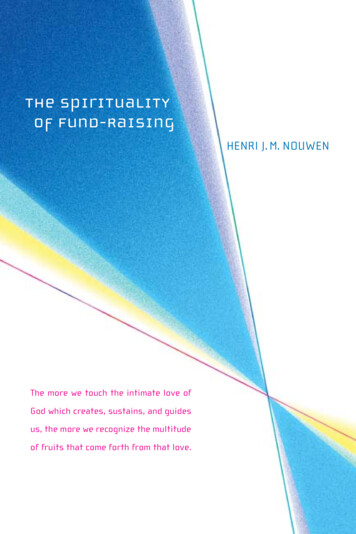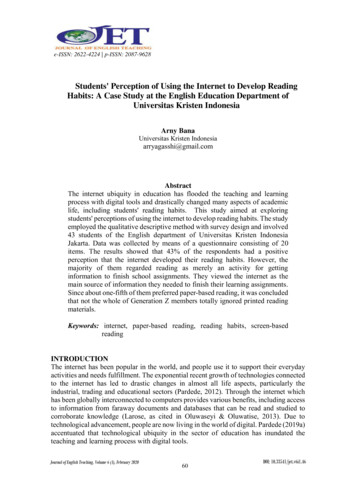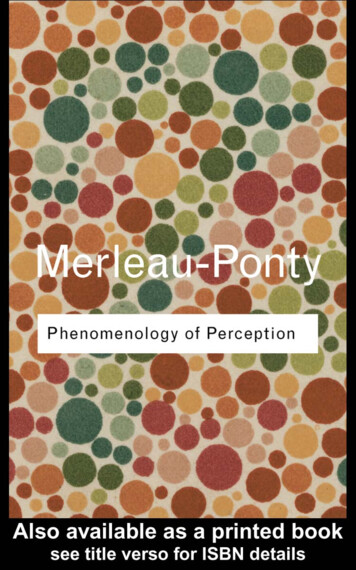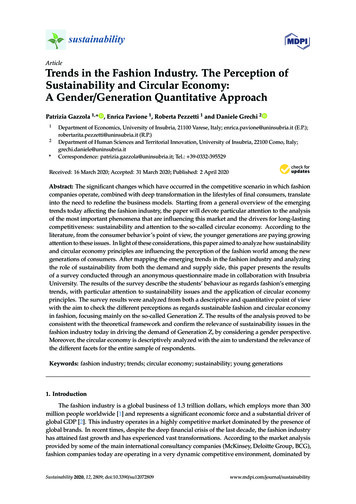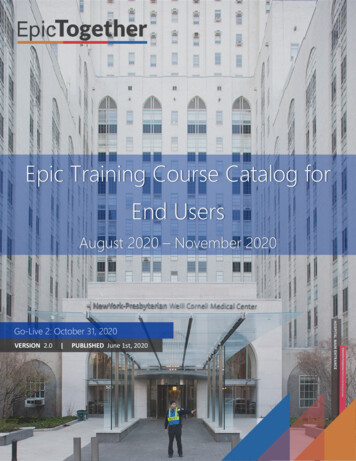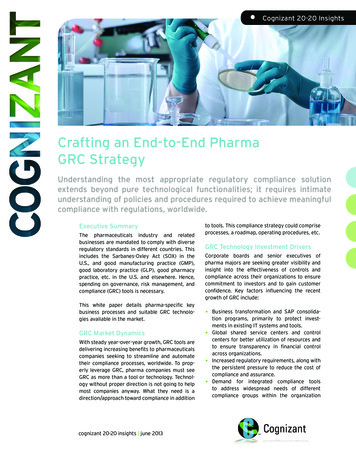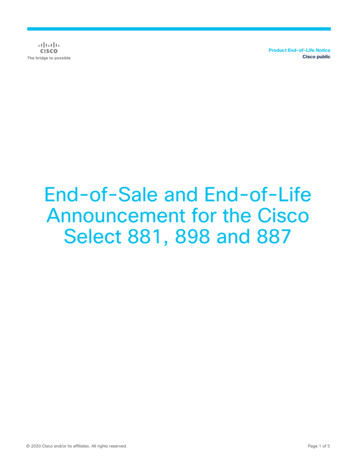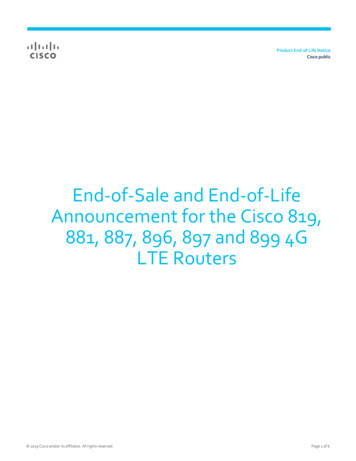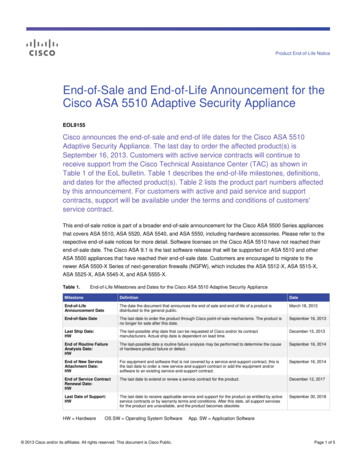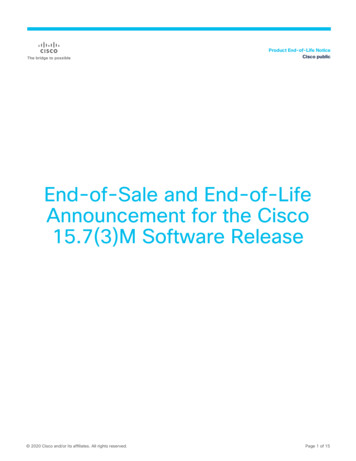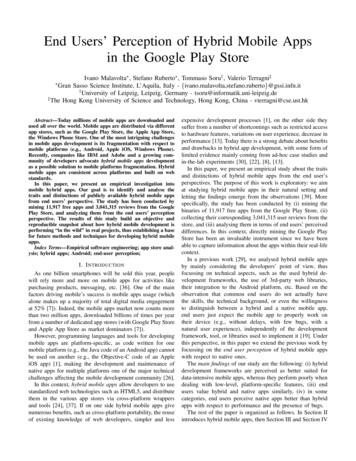
Transcription
End Users’ Perception of Hybrid Mobile Appsin the Google Play StoreIvano Malavolta , Stefano Ruberto , Tommaso Soru† , Valerio Terragni‡Sasso Science Institute, L’Aquila, Italy - {ivano.malavolta,stefano.ruberto}@gssi.infn.it† University of Leipzig, Leipzig, Germany - tsoru@informatik.uni-leipzig.de‡ The Hong Kong University of Science and Technology, Hong Kong, China - vterragni@cse.ust.hk GranAbstract—Today millions of mobile apps are downloaded andused all over the world. Mobile apps are distributed via differentapp stores, such as the Google Play Store, the Apple App Store,the Windows Phone Store. One of the most intriguing challengesin mobile apps development is its fragmentation with respect tomobile platforms (e.g., Android, Apple iOS, Windows Phone).Recently, companies like IBM and Adobe and a growing community of developers advocate hybrid mobile apps developmentas a possible solution to mobile platforms fragmentation. Hybridmobile apps are consistent across platforms and built on webstandards.In this paper, we present an empirical investigation intomobile hybrid apps. Our goal is to identify and analyse thetraits and distinctions of publicly available hybrid mobile appsfrom end users’ perspective. The study has been conducted bymining 11,917 free apps and 3,041,315 reviews from the GooglePlay Store, and analyzing them from the end users’ perceptionperspective. The results of this study build an objective andreproducible snapshot about how hybrid mobile development isperforming “in the wild” in real projects, thus establishing a basefor future methods and techniques for developing hybrid mobileapps.Index Terms—Empirical software engineering; app store analysis; hybrid apps; Android; end-user perception;I. I NTRODUCTIONAs one billion smartphones will be sold this year, peoplewill rely more and more on mobile apps for activities likepurchasing products, messaging, etc. [36]. One of the mainfactors driving mobile’s success is mobile apps usage (whichalone makes up a majority of total digital media engagementat 52% [7]). Indeed, the mobile apps market now counts morethan two million apps, downloaded billions of times per yearfrom a number of dedicated app stores (with Google Play Storeand Apple App Store as market dominators [7]).However, programming languages and tools for developingmobile apps are platform-specific, as code written for onemobile platform (e.g., the Java code of an Android app) cannotbe used on another (e.g., the Objective-C code of an AppleiOS app) [1], making the development and maintenance ofnative apps for multiple platforms one of the major technicalchallenges affecting the mobile development community [26].In this context, hybrid mobile apps allow developers to usestandardized web technologies such as HTML5, and distributethem in the various app stores via cross-platform wrappersand tools [24], [37]. If on one side hybrid mobile apps givenumerous benefits, such as cross-platform portability, the reuseof existing knowledge of web developers, simpler and lessexpensive development processes [1], on the other side theysuffer from a number of shortcomings such as restricted accessto hardware features, variations on user experience, decrease inperformance [13]. Today there is a strong debate about benefitsand drawbacks in hybrid app development, with some form oflimited evidence mainly coming from ad-hoc case studies andin-the-lab experiments [30], [22], [8], [13].In this paper, we present an empirical study about the traitsand distinctions of hybrid mobile apps from the end user’sperspectives. The purpose of this work is exploratory: we aimat studying hybrid mobile apps in their natural setting andletting the findings emerge from the observations [39]. Morespecifically, the study has been conducted by (i) mining thebinaries of 11,917 free apps from the Google Play Store, (ii)collecting their corresponding 3,041,315 user reviews from thestore, and (iii) analysing them in terms of end users’ perceiveddifferences. In this context, directly mining the Google PlayStore has been an invaluable instrument since we have beenable to capture information about the apps within their real-lifecontext.In a previous work [29], we analysed hybrid mobile appsby mainly considering the developers’ point of view, thusfocussing on technical aspects, such as the used hybrid development frameworks, the use of 3rd-party web libraries,their integration to the Android platform, etc. Based on theobservation that common end users do not actually havethe skills, the technical background, or even the willingnessto distinguish between a hybrid and a native mobile app,end users just expect the mobile app to properly work ontheir device (e.g., without delays, with few bugs, with anatural user experience), independently of the developmentframework, tool, or libraries used to implement it [19]. Underthis perspective, in this paper we extend the previous work byfocussing on the end user perception of hybrid mobile appswith respect to native ones.The main findings of our study are the following: (i) hybriddevelopment frameworks are perceived as better suited fordata-intensive mobile apps, whereas they perform poorly whendealing with low-level, platform-specific features, (iii) endusers value hybrid and native apps similarly, (iv) in somecategories, end users perceive native apps better than hybridapps with respect to performance and the presence of bugs.The rest of the paper is organized as follows. In Section IIintroduces hybrid mobile apps, then Section III and Section IV
present (i) the experimental design of our study and (ii) howwe extracted and validated the data, respectively. Section Vdiscusses the results of our study, whereas its threats to validityare discussed in Section VI. Finally, in Section VII discussesrelated works and Section VIII closes the paper.II. H YBRID M OBILE A PPSMobile apps consist of binary executable files that are downloaded directly to the end user’s device and stored locally [1].When distributed via app stores, mobile apps can be of twotypes: native apps or hybrid apps.Native apps are developed directly atop the services provided by their underlying mobile platform. Those services areexposed via a dedicated Application Programming Interface(API) with methods related to communication and messaging,graphics, location, security, etc. [17]. Native apps can interactwith the platform API only via platform-specific programminglanguages (e.g., Java for Android and Objective-C for iOS).Differently from native apps, hybrid mobile apps are developed by using standard web technologies (i.e., HTML5, CSS3,and JavaScript) and all service requests to the Platform API aremirrored by a cross-platform JavaScript API. In this context,an hybrid development framework (e.g., Apache Cordova) canbe defined as a software component that allows developers tocreate a cross-platform web-based mobile app by providing (i)a native wrapper for containing the web-based code, and (ii)a generic JavaScript API that bridges all the service requestsfrom the web-based code to the correspoding platform API.Thanks to the native wrapper, an hybrid mobile app can bepackaged, deployed, and distributed for any supported mobileplatform, like Android, iOS, or Windows Phone [1]. Amongthe various advantages already discussed in Section I, hybriddevelopment frameworks help in managing one of the mostrecognised issues in mobile app development: portability [38].Indeed, they allow developers to create a single mobile appusing web standards, and to consistently distribute it acrossmultiple mobile platforms with (minimal to) no changes.In the following we present the research questions wetranslated from the above mentioned goal: What is the difference between hybrid and nativemobile apps as perceived by end users?– RQ1: What is the difference in the perceived valuebetween hybrid and native mobile apps?– RQ2: What is the difference in the perceived performance between hybrid and native mobile apps?– RQ3: What is the difference in the perceived bugginess between hybrid and native mobile apps?– RQ4: What is the difference in the initial downloadoverhead between hybrid and native mobile apps?Basically, we focus on the end user perception of hybridmobile apps with respect to native ones. In this context,we identified the four main concerns that an end user mayhave with respect to a mobile app: its value, its performance,the presence of bugs, its initial download overhead. Theseconcerns come from the current state of the practice, as we arecontinuously performing informal interviews with developersand end users1 .B. Study planningThe context of our study consists of the free Android appsdistributed in the Google Play Store. We decided to analysemobile apps in the Google Play Store because of its largemarket share. Also, as of the third quarter of 2014, the numberof downloads from the Google play Store is higher than thosefrom other app stores[14]. Moreover, thanks to previous effortsfrom other researchers and developers [28], [21], downloadingapp binaries and apps metadata (e.g., user ratings, currentversion, requested permissions) from the Google Play Storeis relatively straightforward.Objects of our study are 11,917 free Android apps andtheir 3,041,315 user reviews automatically extracted from theGoogle Play Store.In Table II we compactly show the dependent variables ofour study, together with their corresponding research questionsand scale types.III. D ESIGN OF THE S TUDYIn this section we will present the research questions drivingour study, and its investigation plan (i.e., its object, context,and dependent variables).A. Research QuestionsWe formulate the goal of this research by using theGoal-Question-Metric perspectives (i.e., purpose, issue, object,viewpoint [11]). Table I shows the result of the above mentioned formulation.TABLE IG OAL OF THIS RESEARCHPurposeQuality focusObjectContextViewpointIdentify and analysethe traits and distinctionsof hybrid mobile appsin the Google Play Storefrom the end users’ viewpoint.TABLE IID EPENDENT VARIABLES OF THE STUDYVariable gginesssizeResearch questionRQ1RQ1RQ1RQ2RQ3RQ4Scale typeRatioRatio (pair)RatioRatio (pair)RatioRatioSince we are considering hybrid development frameworksfrom the end users’ viewpoint, we will consider the reviewsand ratings provided by the end users of each mobile app. Thisis in line with recent research trends studying aspects related toword-of-mouth of specific products and services [34], speciallyin the fields of book [40], movie sales [16], and finance [12],1 We are working with industry partners and one of the authors is a mobileapplications developer with around thirty projects in his portfolio [25].
[10]. Under this perspective, metrics such as end user ratings,reviews sentiment, and reviews scores with respect to specificaspects of the mobile app (e.g., bugginess), reflect usersperceived value of the mobile app itself. In the followingwe will go through the dependent variables we identified foranswering all the questions of this study: rating: this variable is estimated as the average ratingprovided by the users the mobile app as coming from the5-stars ratings in the Google Play Store. The rating variableis defined as a real number in the range between 1 and 5. reviewsPolarity: it represents the polarity of sentiments ofend users towards the mobile app. By building on the definitionprovided by Asur and Huberman [9], the reviews polarity Paof a mobile app a is defined as:Pa posa negaposa nega(1)where posa is the number of end user reviews with positivesentiments, and nega is the number of end user reviews withnegative sentiments. Section IV-A (point 5) provides the detailson how we compute the sentiment of a single review. reviewsCount: based on the fact that in principles highquality mobile apps tend to get more reviews in its applifecycle [15], this variable represents the number of reviews ofthe mobile app provided by end users. Values of this variablebelong to the set of natural numbers. performance: it represents the perceived performance levelof the app in terms of, e.g., fast UI, quick tasks execution, etc.This variable is defined similarly to reviewsPolarity, where theposa and nega auxiliary functions are computed as the numberof end user reviews mentioning good or bad performance ofthe app, respectively (Section IV-A (point 5) provides thedetails on this). bugginess: this variable represents a score related to theperceived presence of bugs in the mobile app. This valueis estimated as the number of user reviews signalling thepresence of bugs or failures in the app, normalized with respectto the total number of reviews of the app. size: file size in kilobytes of the app APK file (AndroidPacKage).IV. DATA E XTRACTION , VALIDATION , AND A NALYSISTo allow easy replication and verification of our study,we provide to interested researchers a complete replicationpackage. The replication package is publicly available2 andcontains all the data extracted for this study from the GooglePlay Store.A. Data ExtractionOur data extraction process is composed of three main steps.Basing the discussion on Figure 1, in the following we willgo through each of them.1. Apps identification and classification. The first step of ourstudy consists in the identification of our target population.Also, this step involves the classification of the identified2 http://cs.gssi.infn.it/ms2015Fig. 1. Data extraction process.apps with respect to their development strategy (i.e., nativeapps versus hybrid apps). In this context, we reuse an alreadyexisting dataset we produced in a previous work in whichhybrid mobile apps have been analysed by mainly focussingon technical aspects, rather than specifically on end users’perception [29]. The dataset considers the top 500 mostpopular free apps for each category of the Google Play Store,as of November 23, 2014. This kind of selection is mainlydue to the fact that performing a mere random selection ofapps across the whole Google Play Store, may have resultedin a population with a large number of fake or malicious appswith few reviews [27], thus potentially leading us either topartial or misleading results. By following the guidelines in[39, §10.2], from the 27 categories of the Google Play Store,we exclude the Widget and Live Wallpaper categories becausethey are redundant as they are aggregations of apps belongingto other categories. Also, some apps have been removed fromthe dataset either because they were not available to downloadat the time of writing or because they have been encoded in away that reverse engineering them is not possible. The resultof this step is a list of 11,917 app IDs, each of them classifiedaccording to the identified 25 categories of the Google PlayStore. Table III presents a summary of the selected apps andcategories, their complete list is available in our replicationpackage.The classification of mobile apps with respect to theirhybrid nature has been performed via a data-extraction toolwe developed in the context of the previous work [29].The tool is publicly available on GitHub [5] and we areactively maintaining it. Our APK data extraction tool is able toautomatically get a series of information about a mobile appby analyzing the various resources contained into its APK file.In this paper, we focus on the ability of the tool to distinguishwhether a mobile app is native or hybrid, and to extract itsfile size (see the size dependent variable of our study). Thetool has been developed in Java and it is based on two opensource third-party libraries, that are: android-apktool [2] todecode APK files and dex2jar [4] to obtain a Jar archive froman APK file, and so making it more easy to inspect.2. App reviews mining. We extracted and stored end userreviews of each selected app. Collecting all reviews of eachapp is not practical since very popular apps have millionsof reviews, so we limited our data extraction on the mosthelpful ones. The helpfulness score of a review is provided bythe Google Play Store using a free voting system (a thumbsup/thumbs down option). This score is a reasonable metric of
review quality. Google Play Store presents reviews in pageswith a variable number depending on their length. We orderedthe reviews according to their helpfulness score and collectedup to 50 of these pages. We collected a total of 3,041,315reviews, the average number of reviews per app is 255 with amedian of 132.3. Reviews data extraction. We performed the review analysisin order to quantify variables in the second half of table II.When a review is classified as relevant to a variable, thecorresponding value is updated.To evaluate the reviews we adopted a vector space modelfor document representation, thus following a classical Information Retrieval approach for document indexing andsearching [33]. As our aim was to build a model well-suitedfor keyword search, we chose a cosine similarity measure.In this paper, the cosine similarity is the dot product oftwo tf-idf vectors representing the review and the set ofkeywords of interest. These sets are textual representations ofthe variable semantics we then estimated. The cosine similaritythus measures the relevance of each review with respect to thedifferent variables. The review analysis has been articulated inthree main steps: Keywords selection: We asked two domain experts toextract keywords from 300 reviews, in order to representthe variables; As keywords are the typical variablesrepresentation in the text of the reviews, 300 reviews havebeen read by humans to select the significant words andexpressions. Construction of the vectors and cosine similarity calculation; Evaluation of the reviews.In the last step we considered relevant reviews having a cosinesimilarity above an experimental threshold. Whenever the variable is determined by a tuple, only the highest correspondencein the tuple is updated.The only exception to this algorithm is the rating variablethat is computed by averaging the rate in any single review.In our pipeline, we used Apache Mahout [3] to compute tfidf vectors and the cosine similarity. The use of a scalablesoftware was of central importance to handle data aboutmillions of reviews. Since our variable representatives weredefined beforehand, we preferred an approach based on rawcosine similarity over unsupervised learning methods (e.g.,crisp and fuzzy K-Means for clustering). In fact, while theseclustering algorithms update the centroid at each iteration, ourapproach builds up the cluster from a given set of centroids.B. Data ValidationIn this context we aim at verifying if the extracted data iscomplete, reasonable and within acceptable boundaries [39].Our validation process consists in the following checks.1. assertion-checking [32]. We ensure that the values of ourextracted variables belong to their value domains (i.e., set ofpermissible values). For example, for each appi we performedthe following assertions: appi .rating [20, 100]appi .reviewsPolarity [ 1, 1]appi .reviewsCount 0 appi .performance [ 1, 1] appi .bugginess [0, 1] appi .size 02. consistency-checking [32]. We also ensure that the valueof one variable is logically compatible with that of some othervariable.Moreover, we performed a series of qualitative analyses tocheck the correctness of the extracted data. First, in order tovalidate the correlation among user-generated feedback, wecomputed the Pearson coefficient between the app averagerating and the polarity of its reviews. We obtained a valueof p 0.8 by considering only apps having at least k 30reviews with some polarity value associated to them.We then performed a manual evaluation on a subset ofreviews to check how correctly the unsupervised analysison the reviews has been performed. On a random test setcontaining 100 reviews, 87% of them were classified correctly. V
–RQ4: What is the difference in the initial download overhead between hybrid and native mobile apps? Basically, we focus on the end user perception of hybrid mobile apps with respect to native ones. In this context, we identified the four main concerns that an end user may have

